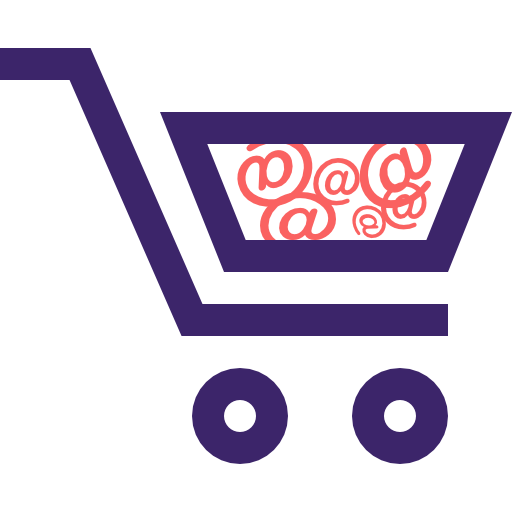Subscription
Audiences, targeting and signups
A few weeks ago we closed on our new house in Dublin. This weekend we’re going to one of those ‘home shows’ where people try and sell you all sorts of things for your home. We know there are some things we want to do with the house so we’re headed out to the convention centre this weekend. Tickets are “free” but they ask for contact information, including an email address.
Read MoreTools aren’t a luxury
I was on the phone with a colleague recently. They were talking about collecting a bit of data over the weekend and mentioned how great it was they had the tools to be able to do this. Coincidentally, another colleague mentioned that when the subscription bombing happened they were able to react quickly because they had a decent tool chain. I’ve also been working with some clients who are dealing with compliance issues but don’t have the tools they need.
Read MoreCollecting email addresses
One of the primary ways to collect email addresses is from website visitors, and it’s actually a pretty good way to collect addresses. One of the more popular, and effective, techniques is through a pop-up window, asking for an address. Users need to provide an address or click a “no thanks” link or close the window. I’ve noticed, though, that many companies drop something passive aggressive in their “no thanks” button. “No, thanks, I don’t want to save money.” “I don’t need workout advice.”
Read MoreNovember 2017: The Month in Email
We’re in the thick of the busiest time of the year for email. It’s been so busy, in fact, that we’ve seen some slowdowns and delivery issues across the email universe. It may be worth thinking about alternate strategies for end of year promotions beyond Black Friday and Cyber Monday.
I was delighted to chat with Julia Angwin for her ProPublica piece on subscription bombing and abuse prevention. Her piece is a good introduction to the topic, and very much worth reading.
ICYMI, I did a rough analysis of the data from our survey on Google Postmaster Tools. Stay tuned for more insights when I have a moment to explore this further.
Subscription bombing and abuse prevention
A few weeks ago ProPublica was the victim of a subscription bomb attack. Julia Angwin found my blog post on the subject and contacted me to talk about the post. We spent an hour or so on the phone and I shared some of the information we had on the problem. Julie told me she was interested in investigating this further problem further. Today, ProPublica published Cheap Tricks: the Low Cost of Internet Harassment.
For those of us deeply involved in the issue, there isn’t too much that comes as a surprise in that article. But it’s a good introduction to folks who may not be aware of the existence of subscription bombing.
Julia does mention something I have been thinking about: abuse and anonymity online. Can we continue to have anonymous or pseudonymous identities on the Internet? Should we?
One of the challenges a lot of companies are struggling with is that anonymity can protect oppressors as well as their targets. How do we support “good” anonymity without enabling “bad” anonymity? I’ve always thought anonymity was an overall good and the fact that it’s abused sometimes didn’t mean it should be taken away. Banning anonymity online might seem to fix the problem of abuse, except it really doesn’t and it comes with its own set of problems.
Let’s be honest, these are hard questions and ones that do need to be addressed. A lot of the tools abuse and security desks currently have rely on volume of complaints. This can result in the targets getting shut down due to false complaints while the perpetrators keep their accounts open. It means subscription bombs can target a few individuals and occur undetected for months.
Big companies in Silicon Valley love to rely on their algorithms and machine learning and AI and code to automate things. But the automation only works after you create working processes. Throwing code at the problem doesn’t work unless you have a picture of the scope of the problem. And a reliance on code ends up with Facebook asking people to upload nudes of themselves to prevent nudes on Facebook. Likewise, throwing cheap labor at the problem isn’t a solution, either.
I don’t have the answers, I don’t think anyone does. But we need to think harder about these problems and address them sooner rather than later. The internet is too important to let abusers break it.
Not a customer you want
Earlier this week one of my ESP clients contacted me. They have a new (potential?) customer dealing with some delivery challenges. Client was looking for advice on how to move the customer over and improve their delivery at the same time.
My advice was actually pretty simple: this isn’t a customer you want. Walk away.
I reached that conclusion about 10 seconds after I loaded the customer’s website. Because I know sometimes initial impressions are wrong, I did spend about 10 more minutes poking around. What I found did nothing to change my mind or convince me my initial impression was wrong. In fact, everything I found reinforced the belief that this was not a good customer for my client.
I sent my client an email explaining what I’d found and they agreed. Future deliverability problem averted!
Some of what I found inspired the conversations with spammers blog post from earlier this week. For instance, the website had two different signup forms, each pointing to a different ESP. Both links were dead.
Then I looked at the company’s whois record and found a bunch of cookie cutter websites, all with different domain names, all with the same broken subscription links.
I do this manually and I can’t fathom how you would automate this kind of checking. For me, it seems there absolutely needs to be a human in the loop. But I suspect that there are ways to automate these types of checks.
In any case, there’s a spammer looking for an email service provider. He’s having problems with IP reputation at his current ESP. He sends content and will even share with you the domain he’s using to collect email addresses. Pro tip: try and sign up for his mail before he signs your contract.
Truth of Consequences
“If you want to use another means that violates the law, and every common definition of “spam”, then by all means, go ahead. You can enjoy fines and being added to the ROKSO database,” says a comment on my recent COI blog post. It’s both disconcerting and entirely predictable.
My post was a discussion of what to do with addresses that don’t confirm. Data tells us that there is some value in those addresses – that there are people who won’t confirm for some reason but will end up purchasing from an email. Using COI leaves some fraction of revenue on the table as it were. My post was a short risk analysis of things to think about when making decisions about continuing to mail to people who don’t confirm.
Mentioning COI often brings the only-COI-mail-is-not-spam zealots out of the woodwork, as it did in this case. In this case, we have the commenter first asserting that failure to do COI is a violation of CAN SPAM (it’s not). When this was pointed out, he started arguing with two people who have been actively fighting spam for 20 years (including running a widely used blocklist). Finally, he ends up with the comment asserting that anyone not using COI will end up on ROKSO. It’s as if he thinks that statement will fear other commenters into not having opinions. It can’t because everyone in the discussion, except possibly him, knows that it’s not true.
The worst problem with folks like the commenter is that they think asserting horrible consequences will make people cower. First off, people don’t react well to threats. Secondly, this is a hollow threat and most people reading this blog know it.
There are millions of mailing lists not using COI and have zero risk of ever getting on ROKSO. The only thing hollow threats do is make people not pay attention to what you have to say. Well, OK, and have me write a blog post about how those threats are bad because they’re completely removed from reality.
Exaggerating or lying about consequences is not just wrong, it’s stupid. “Do this or else BAD THING,” is awesome, up until someone decides they’re not going to do this and the bad thing never happens. It makes people less likely or pay any attention to you in the future. It certainly means your opinions and recommendations are not going to be listened to in the future.
I probably go too far the other direction. I can spend too much time contextualizing a recommendation. It’s one of the things I’m trying to get better about. No, client doesn’t need a 4 page discussion of the history of whatever, they just need 2 lines of what they should do. If they need the context, I can provide it later.
In order to effectively modify behavior consequences have to be real. Threats of consequences are meaningless. Any toddler knows this, and can quite accurately model when mom means it and when she’s just threatening.
Risk analysis is not about modifying behavior. It’s about analyzing a particular issue and providing necessary information so the company action understands potential consequences and the chance those risks will happen. The blog post about COI was not intended to modify anyone’s behavior. I know there are companies out there successfully maintaining two mail streams: one COI and one not. I know there are other companies out there successfully mailing only single opt-in mail. I know there are companies with complex strategies to verify identity and address ownership. And I smile every time I walk into a retail store and they ask me if my email address is still X and if I want to make any changes to it.
Lying about consequences does nothing to modify behavior. All it does is diminish the standing and audience of the liar. Be truthful about the consequences of an action or lack of action. Don’t make up threats in order to bully people into doing what you think is right. Sooner or later they’re going to realize that you don’t know what you’re talking about and start to ignore you.
Confirmed Opt-In: An Old Topic Resurrected
Looking back through my archives it’s been about 4 years or so since I wrote about confirmed opt in. The last post was how COI wasn’t important, but making sure you were reaching the right person was important. Of course, I’ve also written about confirmed opt-in in general and how it was a tool somewhat akin to a sledgehammer. I’m inspired to write about it today because it’s been a topic of discussion on multiple mailing lists today and I’ve already written a bunch about it (cut-n-paste-n-edit blog post! win!).
Confirmed opt-in is the process where you send an email to a recipient and ask them to click on a link to confirm they want the mail. It’s also called double opt-in, although there are some folks who think that’s “spammer” terminology. It’s not, but that’s a story for another day. The question we were discussing was what to do with the addresses that don’t click. Can you email them? Should you email them? Is there still value in them?
We have to treat the addresses as a non-homogenous pool. There are a lot of reasons confirmation links don’t get clicked.
Poor delivery at Gmail but no where else
I’ve mentioned before that I can often tell what ISP is making filter changes by what my calls are about. The last few weeks it’s been Gmail where folks are struggling to get to the inbox. One of the things most clients and potential clients have mentioned is that they’re not having any problems at the other major ISPs.
Read MoreListbombing Webinar
Earlier this week I gave a webinar hosted by the EEC and the DMA discussing the listbombing problem. They will be making the recording available later this week and I will link to it then.
I wish I could say the issue was done and over with and that it was something we don’t have to worry about any longer. Unfortunately, that’s just not the case. Attacks are ongoing. Many of them are being caught and mitigated, but they’re still occurring.
We can’t let up our guard, though. Attackers will adapt to the mitigations and negate them.
And remember, listbombing is a sign that your subscription process is not collecting accurate data. If Evil Bob or Dumb Bob can give you Real Bob’s address then your data is all suspect. The problem is somewhat in the form, but it’s also in the whole process. What steps can you take to verify data without creating too much friction in the process?
This is an opportunity for forward thinking companies to reconsider their subscription and address acquisition processes. How do we get Bob’s address and information without Evil Bob or Dumb Bob giving us bad data and without contributing to the overall abuse online.
Ongoing subscription form abuse
Last week Spamhaus posted information on the ongoing subscription attacks. They provided a more information about them that was not make public previously, including some information about the volume of mail some targets received.
Today SendGrid also blogged about this, going into a little more detail about why senders should care about this. They also provided a number of suggestions for how to mitigate the risk of being part of an attack.
There are a couple of things I think it’s important for folks to realize.
Spamhaus and subscription bombing
Spamhaus released a blog post today discussing the recent subscription bombing: Subscription bombing COI captcha and the next generation of mail bombs.
As I mentioned in my initial posts, this abusive behavior goes beyond spamming. This is using email to harass individuals. Spamhaus even mentions a potential service that can be used to do these kinds of mailbombing.
Things folks need to know is that this is not just about ESPs and commercial mail. One of the big targets was WordPress admin forms. As Spamhaus says:
Incentivizing incites fraud
There are few address acquisition processes that make me cringe as badly as incentivized point of sale collection. Companies have tried many different ways to incentivize address collection at the point of sale. Some offer the benefit to the shopper, like offering discounts if they supply an email address. Some offer the benefits to the employee. Some offer punishments to the employee if they don’t collect addresses from a certain percentage of customers.
All of these types of incentive programs are problematic for email collection.
On the shopper side, if they want mail from a retailer, they’ll give an address simply because they want that mail. In fact, asking for an address without offering any incentive is way more likely to get their real address. If they don’t want mail but there is a financial incentive, they’re likely to give a made up address. Sometimes it will be deliverable, but belong to another person. Sometimes it will be undeliverable. And sometimes it will be a spamtrap. One of my delivery colleagues occasionally shares addresses she’s found in customer lists over on her FB page. It’s mostly fun stuff like “dont@wantyourmail.com” and “notonyour@life.com” and many addresses consisting of NSFW type words.
On the employee side there can also be abuses. Retailers have tried to tie employee evaluations, raises and promotions to the number of email addresses collected. Other retailers will actively demote or fire employees who don’t collect a certain number of addresses. In either case, the progression is the same. Employees know that most customers don’t want the mail, and they feel bad asking. But they’re expected to ask, so they do. But they don’t push, so they don’t get enough addresses. Eventually, to protect their jobs, they start putting in addresses they make up.
Either way, incentivizing point of sale collection of information leads to fraud. In a case I read about in the NY Times, it can lead to fraud much more serious than a little spam. In fact, Wells Fargo employees committed bank fraud because of the incentives related to selling additional banking products at the teller.
Open subscription forms going away?
A few weeks ago, I got a call from a potential client. He was all angry and yelling because his ESP had kicked him off for spamming. “Only one person complained!! Do you know him? His name is Name. And I have signup data for him! He opted in! How can they kick me off for one complaint where I have opt-in data? Now they’re talking Spamhaus listings, Spamhaus can’t list me! I have opt-in data and IP addresses and everything.”
We talked briefly but decided that my involvement in this was not beneficial to either party. Not only do I know the complainant personally, I’ve also consulted with the ESP in question specifically to help them sort out their Spamhaus listings. I also know that if you run an open subscription form you are at risk for being a conduit for abuse.
This abuse is generally low level. A person might sign up someone else’s address in an effort to harass them. This is a problem for the victim, but doesn’t often result in any consequences for the sender. Last week’s SBL listings were a response to subscription abuse happening on a large scale.
Ongoing subscription attack
Brian Krebs posted a couple days ago about his experience with the subscription bomb over the weekend. He talks about just how bad it was over the weekend.
Read MoreJuly 2016: The Month in Email
We got to slow down — and even take a brief vacation — in July, but we still managed to do a bit of blogging here and there, which I’ll recap below in case you missed anything.
At the beginning of the month, I wrote about email address harvesting from LinkedIn. As you might imagine, I’m not a fan. A permissioned relationship on social media does not equate to permission to email. Check out the post for more on mailing social media contacts.
Even people who are collecting addresses responsibly can face challenges. One of the most important challenges to address is paying attention to your existing subscription processes, testing them regularly, evaluating effectiveness and optimizing as needed.
Our most commented-upon post this month was a pointer to a smart writeup about Hillary Clinton’s email server issues. Commenters were pretty evenly split between those who agreed that they see this kind of workaround frequently, and those who felt like regulatory processes do a good job managing against this kind of “shadow IT” behavior. I wrote a followup post on why we see this kind of workaround frequently in email environments, even in regulated industries, and some trends we’re seeing as things improve.
In other election-related email news, we saw the challenges of campaign email being flagged as spam. As I pointed out, this happens to all campaigns, and is nothing unique to the Trump campaign. Still, there are important lessons for marketers here, too, in terms of list management, email content, frequency, and engagement — all of which are inextricably linked to deliverability.
Speaking of spam and engagement, Steve took a look at some clickthrough tracking revealed through a recent spam message I received — and why legitimate marketers should avoid using these sorts of URL referrers.
On the topic of authentication, I wrote a quick post about how seeing ?all in the SPF record tells me one thing: the person managing the record isn’t doing things properly. Need a refresher on authentication? Our most-read blog post of all time can help you out.
And as always, send me your interesting questions and I’ll be happy to consider them as I resume my Ask Laura column in August.
Growing your list carefully
Karl Murray wrote a great set of recommendations for growing an email marketing list. I really can’t think of anything I would have said differently. Touching customers and getting contact information from them is great, but there are situations where this gets bad addresses. Too many bad addresses can impact delivery.
So how do you grow your list without falling into a delivery trap? The specific recommendations, as always, depend on your specific situation. But knowing how bad addresses get onto your list will allow you to implement mitigation strategies that actually work.
Harvesting and forging email addresses
For the contact address on our website, Steve has set up a rotating set of addresses. This is to minimize the amount of spam we have to deal with coming from address harvesters. This has worked quite well. In fact it works so well I didn’t expect that publishing an email address for taking reader questions would generate a lot of spam.
Boy, was I wrong. That address has been on the website less than a month and I’m already getting lots of spam to it. Most of it is business related spam, but there’s a couple things that make me think that someone has been signing that address up to mailing lists.
One is the confirmation email I received from Yelp. I don’t actually believe Yelp harvested my address and tried to create me an email account. I was happy when I got the first mail from Yelp. It said “click here to confirm your account.” Yay! Yelp is actually using confirmations so I just have to ignore the mail and that will all go away.
At least I was happy about it, until I started getting Yelp newsletters to that address.
Yelp gets half a star for attempting to do COI, but loses half for sending newsletters to people who didn’t confirm their account.
I really didn’t believe that people would grab a clearly tagged address off the blog and subscribe it to mailing lists or networking sites. I simply didn’t believe this happened anymore. I know forge subscribing used to be common, but it does appear that someone forge signed me up for a Yelp account. Clearly there are more dumb idiots out there than I thought.
Of course, it’s not just malicious people signing the address up to lists. There are also spammers harvesting directly off the website.
I did expect that there would be some harvesting going on and that I would get spam to the address. I am very surprised at the volume and type of spam, though. I’m getting a lot of chinese language spam, a lot of “join our business organization” spam and mail claiming I subscribed to receive their offers.
Surprisingly, much of the spam to this address violates CAN SPAM in some way shape or form. And I can prove harvesting, which would net treble damages if I had the time or inclination to sue.
It’s been an interesting experience, putting an unfiltered address on the website. Unfortunately, I am at risk of losing your questions because of the amount of spam coming in. I don’t think I’ve missed any, yet, but losing real mail is always a risk when an address gets a lot of spam – whether or not the recipient runs filters.
I’m still pondering solutions, but for now the questions address will remain as it is.
Leaving money on the table
On August 1 two domains in the Netherlands are going away: wanadoo.nl and orange.nl. Current users of these domains are being transitioned to new addresses at online.nl. Mailchimp has more information and links.
This is a good time for all of us to consider how easy it is for a subscriber to change their address of record. Some senders just have the subscriber unsubscribe from one address and resubscribe for another. This sounds like the simplest way to do things, and it certainly doesn’t take much engineering effort.
But what information do you lose by simply asking subscribers to unsubscribe and resubscribe? It depends on what you’re tracking, but you do lose everything that you track. Preferences, interaction history, purchase history, it’s all gone. Providing a simple way to change an email address of record preserves the information related to that subscriber.
For some senders, keeping subscriber information through different ISPs and email addresses will pay for the development of a preference center. For others, there’s no real value there. How much money are companies leaving on the table by not providing a mechanism for recipients to change their email address?
Gathering data at subscription time
I recently received a survey from my Congressional Representative. She wanted to know what I wanted her to focus on in the coming year. I decided to go ahead and answer the survey, as I have some rather strong opinions on some of the stuff happening in Congress these days.
The email itself was pretty unremarkable, although quite well done. I was as much interested in answering the survey because it’s one of the few emails I’ve seen with an embedded survey.
Food for thought
Companies that can’t be bothered to implement good subscription practices will rarely be bothered to send relevant or engaging email.
True or False?
Preferences pages
As often as I talk about how badly companies send mail, I think it’s always a good idea to highlight when I find companies doing good things.
Today’s example of a company making me happy is Sur la Table. I’ve been on their mailing list for quite a while and do enjoy the offers and information they send. With the advent of the holiday cooking season, though, they’ve massively increased their volume. 21 emails in September, 25 emails in October and 37 emails in the month of November.
Choosing Twitter over Email to engage customers
Eric Goldman has an interesting blog post over at hit Technology and Marketing Law blog comparing and contrasting twitter and email. One of the reasons he likes Twitter is that it gives him, the ‘subscriber’ (follower in Twitspeak) control. There’s no chance that the company will sell his data. And, if the company does tweet too much that is uninteresting or irrelevant, the follower can ‘unsubscribe’ (or unfollow) without any fear that the company will override or lose the unsub request.
To my mind, the biggest problem with Twitter for B2C communication is the 140 character limit. On the other hand, it means that companies need to be clear in their language and concise in their tweets. Maybe the limited space is actually a feature not a bug.
List Attrition
DJ over at Bronto blog has a post up about list churn / list attrition. She quotes a statistic published by Loren from MediaPost (the original post is behind a subscription wall) that a list will lose 30% of their subscribers year over year. This is similar to a statistic that I use, but the context I have seen the published statistic in is slightly different. DJ offers suggestions on how to reduce this churn. All the suggestions are great, but I think that they slightly miss the point. There are multiple processes that can be described as list churn. One is churn DJ addresses, that is people unsubscribe from a mailing list. The other is people abandon their email addresses. Individual mailers have some control over the first type of churn, but almost no control over the second.
I think the study Loren was quoting describes the second phenomenon not the first. In 2002, ReturnPath published a study that showed 31% of people changed email addresses in a single year. Understand, this does not mean that 31% of recipients on any particular list will actively decide to unsubscribe from a list or report it as spam or otherwise unsubscribe from that list. This is 31% of all email address owners will get a new address and abandon their current one. There are a few reasons for the churn.